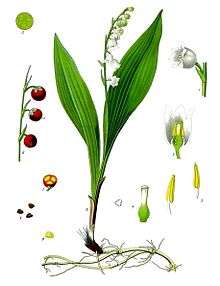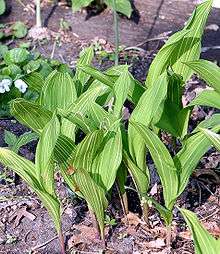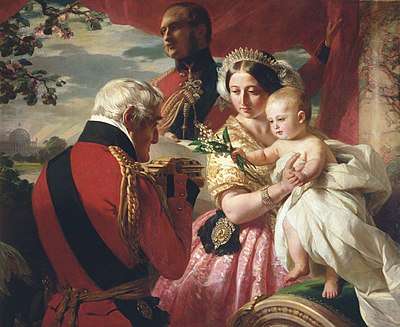Lily of the valley
Lily of the valley, Convallaria majalis (/ˌkɒnvəˈleɪriə məˈdʒeɪlɪs/)[1], sometimes written lily-of-the-valley,[2] is a woodland flowering plant with sweetly scented, pendent, bell-shaped white flowers borne in sprays in spring. It is native throughout the cool temperate Northern Hemisphere in Asia and Europe. Though some non-medical sources claim it is highly poisonous[3], there are no published cases of deaths due to this plant in humans, "most exposures result in minimal or no toxicity"[4], and "confirmed reports of human poisonings by this plant are, however, extremely rare."[5] Large-scale reviews of exposures to lily-of-the-valley have found few people experience any symptoms, and only a tiny minority (0.3%) developed serious but transient symptoms.[6]
| Lily of the valley | |
|---|---|
| Scientific classification | |
| Kingdom: | Plantae |
| Clade: | Tracheophytes |
| Clade: | Angiosperms |
| Clade: | Monocots |
| Order: | Asparagales |
| Family: | Asparagaceae |
| Subfamily: | Nolinoideae |
| Genus: | Convallaria |
| Species: | C. majalis |
| Binomial name | |
| Convallaria majalis | |

It is possibly the only species in the genus Convallaria in the asparagus family.
Other names include May bells, Our Lady's tears, and Mary's tears. Its French name, muguet, sometimes appears in the names of perfumes imitating the flower's scent. In pre-modern England, the plant was known as glovewort (as it was a wort used to create a salve for sore hands), or Apollinaris (according to a legend that it was discovered by Apollo).[7]
Description
Convallaria majalis is an herbaceous perennial plant that often forms extensive colonies by spreading underground stems called rhizomes. New upright shoots are formed at the ends of stolons in summer,[8] these upright dormant stems are often called pips.[9] These grow in the spring into new leafy shoots that still remain connected to the other shoots under ground. The stems grow to 15–30 cm (6–12 in) tall, with one or two leaves 10–25 cm (4–10 in) long; flowering stems have two leaves and a raceme of five to fifteen flowers on the stem apex.
The flowers have six white tepals (rarely pink), fused at the base to form a bell-shape, 5–10 mm (0.2–0.4 in) diameter, and sweetly scented; flowering is in late spring, in mild winters in the Northern Hemisphere it is in early March. The fruit is a small orange-red berry 5–7 mm (0.2–0.3 in) diameter that contains a few large whitish to brownish colored seeds that dry to a clear translucent round bead 1–3 mm (0.04–0.12 in) wide. Plants are self-sterile, and colonies consisting of a single clone do not set seed.[10]
Taxonomy
In the APG III system, the genus is placed in the family Asparagaceae, subfamily Nolinoideae (formerly the family Ruscaceae[11]). It was formerly placed in its own family Convallariaceae, and, like many lilioid monocots, before that in the lily family Liliaceae.
There are three varieties that have sometimes been separated out as distinct species or subspecies by some botanists.[12]
- Convallaria majalis var. keiskei – from China and Japan, with red fruit and bowl-shaped flowers (now widely cited as Convallaria keiskei)[10][13]
- C. majalis var. majalis – from Eurasia, with white midribs on the flowers
- C. majalis var. montana – from the United States, with green-tinted midribs on the flowers
Convallaria transcaucasica is recognised as a distinct species by some authorities, while the species formerly called Convallaria japonica is now classified as Ophiopogon japonicus.[13]
Distribution
Convallaria majalis is a native of Europe, where it largely avoids the Mediterranean and Atlantic margins.[14] An eastern variety, C. majalis var. keiskei occurs in Japan and parts of eastern Asia. A limited native population of C. majalis var. montana (synonym C. majuscula) occurs in the Eastern United States.[15] There is, however, some debate as to the native status of the American variety.[16]
Like many perennial flowering plants, C. majalis exhibits dual reproductive modes by producing offspring asexually by vegetative means and by seed, produced via the fusion of gametes.[17]
Ecology
Convallaria majalis is a plant of partial shade, and mesophile type that prefers warm summers. It likes soils that are silty or sandy and acid to moderately alkaline,[18] with preferably a plentiful amount of humus. The Royal Horticultural Society states that slightly alkaline soils are the most favored.[19] It is a Euroasiatic and suboceanic species that lives in mountains up to 1,500 m (4,900 ft) elevation.[20]
Convallaria majalis is used as a food plant by the larvae of some moth and butterfly (Lepidoptera) species including the grey chi. Adults and larvae of the leaf beetle Lilioceris merdigera are also able to tolerate the cardenolides and thus feed on the leaves.[21]
Cultivation

Convallaria majalis is widely grown in gardens for its scented flowers and ground-covering abilities in shady locations. It has gained the Royal Horticultural Society's Award of Garden Merit.[3][22] In favourable conditions it can form large colonies.
Various kinds and cultivars are grown, including those with double flowers, rose-colored flowers, variegated foliage and ones that grow larger than the typical species.[13]
- C. majalis 'Albostriata' has white-striped leaves
- C. majalis 'Green Tapestry', 'Haldon Grange', 'Hardwick Hall', 'Hofheim', 'Marcel', 'Variegata' and 'Vic Pawlowski's Gold' are other variegated cultivars[13]
- C. majalis 'Berlin Giant' and C. majalis 'Géant de Fortin' (syn. 'Fortin's Giant') are larger-growing cultivars[13]
- C. majalis 'Flore Pleno' has double flowers.[13]
- C. majalis 'Rosea' sometimes found under the name C. majalis var. rosea, has pink flowers.[13]
Traditionally Convallaria majalis has been grown in pots and winter forced to provide flowers during the winter months, both for as potted plants and as cut flowers.[23]
Chemistry
Roughly 38 different cardiac glycosides (cardenolides) have been found in the plant, including:
|
It also contains the unusual, poisonous amino acid azetidine-2-carboxylic acid, though it is not clear this has caused any problems with human ingestion. The plant also contains saponins.
The odor of lily of the valley, specifically the ligand bourgeonal, was thought to attract mammalian sperm.[24] The 2003 discovery of this phenomenon prompted research into odor reception,[25] but a 2012 study demonstrated instead that at high concentrations, bourgeonal imitated the role of progesterone in stimulating sperm to swim (chemotaxis), a process unrelated to odor reception.[26]
Medicinal Use
The plant has been used in herbal medicine in moderate amounts by physicians and herbalists for centuries, particularly for mild congestive heart failure and arrhythmias.[27][28] This herb is not appropriate for use by lay people without expert guidance.
Toxicology
All parts of the plant are potentially poisonous, including the red berries which may be attractive to children.[29] If ingested, the plant can cause abdominal pain, nausea, vomiting, and irregular heart beats, though all of these are extremely rare.[4][5][6]
Uses
Perfume
In 1956, the French firm Dior produced a fragrance simulating lily of the valley, which was Christian Dior's favorite flower. Diorissimo was designed by Edmond Roudnitska.[30] Although it has since been reformulated, it is considered a classic.[30][31]
Other perfumes imitating or based on the flower include Henri Robert's Muguet de Bois (1936),[32] Penhaligon's Lily of the Valley (1976),[30] and Olivia Giacobetti's En Passant (2000).[30]
Weddings and other celebrations

Lily of the valley has been used in weddings[33] and can be very expensive.[34] Lily of the valley was featured in the bridal bouquet at the wedding of Prince William and Catherine Middleton.[34][35] Lily of the valley was also the flower chosen by Princess Grace of Monaco to be featured in her bridal bouquet.
At the beginning of the 20th century, it became tradition in France to sell lily of the valley on international labour day, 1 May (also called La Fête du Muguet (Lily of the Valley Day) by labour organisations and private persons without paying sales tax (on that day only) as a symbol of spring.[36]
Lily of the valley is worn in Helston (Cornwall, UK) on Flora Day (8 May each year, see Furry Dance) representing the coming of "the May-o" and the summer. There is also a song sung in pubs around Cornwall (and on Flora Day in Cadwith, near Helston) called "Lily of the Valley"; the song, strangely, came from the Jubilee Singers from Fisk University in Nashville, Tennessee.[37]
Cultural symbolism
The lily of the valley was the national flower of Yugoslavia,[38] and it also became the national flower of Finland in 1967.[39]
In the "language of flowers", the lily of the valley signifies the return of happiness.[33]
In terms of musical influence, “Lily of the Valley” is also a song by Queen on their album Sheer Heart Attack.
Lily of the Valley was featured in the TV show Breaking Bad, as it was used by Walter White as a naturally occurring poison.
It was also featured in the TV show Outlander, where a boy mistook it with wood garlic (Allium ursinum) and poisoned himself by eating the plant. However, the plant depicted looked nothing like lily-of-the-valley.
In the Animal Crossing franchise these flowers appear when the players town is deemed to be in perfect condition. In earlier games they were referred to as Jacob's Ladders due to a translation error.
Christian traditions
Two of the flower's alternative names — Our Lady's tears and Mary's tears — derive from Christian legends that it sprang from the weeping of the Virgin Mary during the crucifixion of Jesus. Other etiologies have its coming into being from Eve's tears after she was driven with Adam from the Garden of Eden.[40]
The name "lily of the valley", like its correspondences in some other European languages, is apparently a reference to the phrase "lily of the valleys" (sometimes also translated as "lily of the valley") in Song of Songs 2:1 (in Hebrew: "shoshannat-ha-amaqim"). European herbalists' use of the phrase to refer to a specific plant species seems to have appeared relatively late in the 16th[41] or 15th century.[42] The New Latin term convallaria (coined by Linnaeus) and, for example, Swedish name liljekonvalj derive from the corresponding phrase lilium convallium in the Latin Vulgate.
It is a symbol of humility in religious painting. Lily of the valley is considered the sign of Christ's second coming.
Gallery
 Convallaria close-up
Convallaria close-up Moldovan stamp
Moldovan stamp 1 May, by Franz Xaver Winterhalter
1 May, by Franz Xaver Winterhalter Lunner (Norway) municipal coat of arms
Lunner (Norway) municipal coat of arms
References
- Sunset Western Garden Book, 1995:606–607
- "BSBI List 2007". Botanical Society of Britain and Ireland. Archived from the original (xls) on 2014-10-23. Retrieved 2014-10-17.
- "Convallaria majalis". RHS. Retrieved 2020-04-17.
- Nelson, LS; Shish, RD; Balick, MJ (2007). Handbook of Poisonous and Injurious Plants. Springer Science & Business Media. pp. 133-4. ISBN 9781493989249.
- Lewis, RA (1998). Lewis' Dictionary of Toxicology. CRC Press. p. 309. ISBN 9781566702232.
- Ellenhorn, MJ; Caravati, EM; McGuigan, MA (2004). Medical Toxicology. Lippincott, Williams & Wilkins. p. 1703. ISBN 9780781728454.
- Cockayne, Thomas Oswald (1864). Leechdoms, Wortcunning, and Starcraft of Early England: Being a Collection of Documents, for the Most Part Never Before Printed, Illustrating the History of Science in this Country Before the Norman Conquest. London: Longman, Green, Longman, Roberts, and Green. pp. 121.
glovewort.
- Flora of China: Convallaria majalis
- Mills, Linn; Post, Dick (2005). Nevada gardener's guide. Nashville, Tenn.: Cool Springs Press. p. 137. ISBN 978-1-59186-116-4.
- Ohara, Masashi; Araki, Kiwakoi; Yamada, Etsukoi; Kawano, Shoichi, Life-history monographs of Japanese plants, 6: Convallaria keiskei Miq. (Convallariaceae), Plant Species Biology, Vol 21, No 2, August 2006, pp. 119–126(8), Blackwell Publishing
- Chase, M.W.; Reveal, J.L. & Fay, M.F. (2009), "A subfamilial classification for the expanded asparagalean families Amaryllidaceae, Asparagaceae and Xanthorrhoeaceae", Botanical Journal of the Linnean Society, 161 (2): 132–136, doi:10.1111/j.1095-8339.2009.00999.x
- "Convallaria in Flora of North America @". Efloras.org. Retrieved 2012-04-30.
- RHS Plant Finder 2009–2010. Dorling Kindersley. 2009. pp. 195, 196. ISBN 978-1-4053-4176-9.
- "Liljekonvalj Blomningstid" (in Swedish). Retrieved 16 May 2018.
- Flora of North America : Convallaria majalis
- Gleason, Henry A. and Cronquist, Arthur, (1991), Manual of Vascular Plants of Northeastern United States and Adjacent Canada, New York Botanical Garden, Bronx, New York, pp. 839-40
- Vandepitte, Katrien; De Meyer, Tim; Jacquemyn, Hans (February 2013). "The impact of extensive clonal growth on fine-scale mating patterns: a full paternity analysis of a lily-of-the-valley population (Convallaria majalis)". Annals of Botany. 111 (4): 623–628. doi:10.1093/aob/mct024. PMC 3605957. PMID 23439847.
- "Lily of the Valley Planting Guide". easytogrowbulbs.com. Retrieved 12 May 2015.
- RHS Encyclopaedia of Perennials
- Rameau, J. C.; et al. (1989). Flore Forestière Française. Institut pour le développement Forestier. p. 1023. ISBN 978-2-904740-16-9.
- Whitman, Ann. "Controlling Lily Leaf Beetles". Gardner's Supply Company. Retrieved 12 May 2015.
- "AGM Plants - Ornamental" (PDF). Royal Horticultural Society. July 2017. p. 22. Retrieved 24 January 2018.
- Journal of horticulture and practical gardening. 1872. p. 378. Retrieved 28 September 2010.
- Marc Spehr; Günter Gisselmann; Alexandra Poplawski; Jeffrey A. Riffell; Christian H. Wetzel; Richard K. Zimmer; Hanns Hatt (2003). "Identification of a Testicular Odorant Receptor Mediating Human Sperm Chemotaxis". Science. 299 (5615): 2054–8. Bibcode:2003Sci...299.2054S. doi:10.1126/science.1080376. PMID 12663925. Retrieved 24 June 2012.
- See also: Babcock, Donner F. (28 March 2003). "Development. Smelling the Roses?" (PDF). Science. 299 (5615): 1993–1994. doi:10.1126/science.1083059. PMID 12663902. Archived from the original (PDF) on 4 May 2006. Retrieved 12 June 2014..
- For example ScienceDaily 2007
- Christoph Brenker; Normann Goodwin; Ingo Weyand; Nachiket D Kashikar; Masahiro Naruse; Miriam Krähling; Astrid Müller; U Benjamin Kaupp; Timo Strünker (2012). "The CatSper channel: a polymodal chemosensor in human sperm". The EMBO Journal. 31 (7): 1654–1665. doi:10.1038/emboj.2012.30. PMC 3321208. PMID 22354039. See also ScienceMag article
- Weiss, RF (1988). Herbal Medicine. Ab Arcanum. p. 146-147. ISBN 9780906584194.
- Felter, HW; Lloyd, JU (1898). King's American Dispensatory (18th ed.). Cincinnati: Ohio Valley Co.
- "Lily-Of-The-Valley". The New York Times.
- "Lily of the Valley Perfumes". Vogue slideshow.
- Patty. "Best Lily of the Valley Perfume – Muguet Guide". Perfume Posse, April 8, 2013.
- Morris, Edwin T. (1984). Fragrance : A story of perfume from Cleopatra to Chanel. New York: Scribners. ISBN 978-0684181950.
- "Wedding Traditions & Trivia". Archived from the original on 2012-07-15. Retrieved 2012-07-23.
- Lily of the Valley Stars in Royal Bridal Bouquet
- Balcony kisses seal royal wedding
- "Lily of the Valley – May Day in France". wordpress.com. 26 April 2010. Retrieved 24 June 2015.
- Coleman and Burley, Hilary and Sally (2015). Shout Kernow. London, UK: Francis Boutle Publishers. pp. 53–55. ISBN 978 1 903427 97 2.
- "Lily of the valley". flowers.org.uk. Retrieved 24 June 2015.
- "Lily of the Valley – Finland's National Flower". wordpress.com. 28 May 2013. Retrieved 24 June 2015.
- "May Birth Flower : Birth Month Flower". Birthflowersguide.com. 2007-06-02. Retrieved 2012-04-30.
- https://www.etymonline.com/search?q=lily+of+the+valley
- Keil, Gundolf. „Es hat vnser libe fraw gesprochen in dem puch der libe: ‚Ich pin ein plvm des tals vnd auch des grvnen waldes‘“: Die Einführung der Convallarin-Glykoside als Hinweis auf mährisch-schlesische Provenienz. In: Iva Kratochvilová, Lenka Vaňková (Hrsg.): Germanistik im Spiegel der Generationen. Festschrift Zdeněk Masařík. Opava/ Ostrava 2004, S. 72–132.
Further reading
Vandepitte, Katrien; De Meyer, Tim; Jacquemyn, Hans (February 2013). "The impact of extensive clonal growth on fine-scale mating patterns: a full paternity analysis of a lily-of-the-valley population (Convallaria majalis)". Annals of Botany. 111 (4): 623–628. doi:10.1093/aob/mct024. PMC 3605957. PMID 23439847.
External links
| Wikiquote has quotations related to: Lily of the valley |
| Wikimedia Commons has media related to: |
- Invasive Plant Atlas – US Distribution Map
- Convallaria majalis fact sheet – NC Cooperative Extension